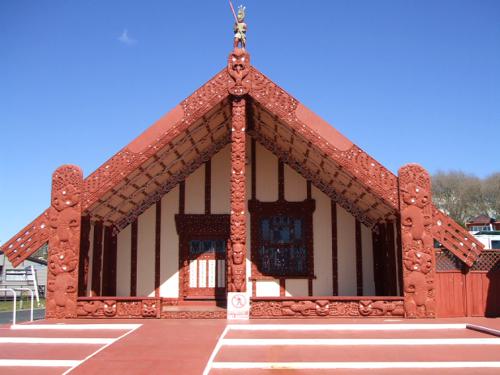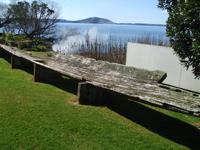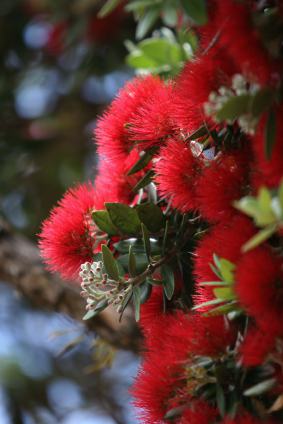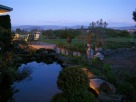- Home
- Top 10 To Visit
- Rotorua Museum
Rotorua Museum
The Rotorua Museum of Art & History building has sure packed a lot into it's relatively short history. Let's take a walk through the corridors of time in this historic building, which I am sure will intrigue and delight.
The Museum is closed until further notice due to earthquake damage.
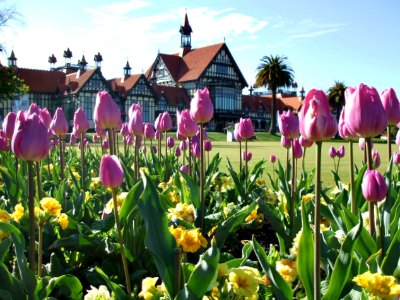 Our Museum of Art & History in springtime
Our Museum of Art & History in springtimeHistory Of This Heritage Building
From it's opening date in 1908 to the present time it has been a spa Bath House, housed a restaurant, nightclub and now a museum. The latter is much more in keeping with the appearance of the building.
Dr Arthur Stanley Wohlmann, from England, was the visionary for the Rotorua Museum building. He was a Balneologist (a physician who specialises in therapies involving mineral waters).
Appointed by the government, his job was to advise on how to improve Rotorua's spa facilities. Within a year of his arrival in 1902 he came up with the design concept for The Bath House building.
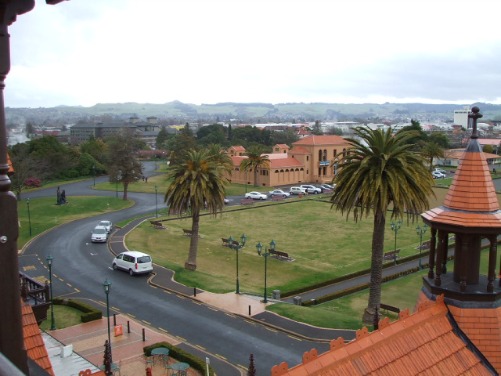 Rotorua Museum, also known as The Bath House - Roof view to the Blue Baths
Rotorua Museum, also known as The Bath House - Roof view to the Blue BathsWith one stipulation the museum was built on land gifted by the Ngāti Whakaue people of Rotorua. It had to be, "a place for all the people of the world - hei oranga mo nga iwi katoa o te Ao."
And that, it surely is. We get thousands of visitors each year from what seems like every country in the world.
The building was only partially completed when it opened in 1908. From 1983 to 2011 major works were carried out, at a cost of about NZ$23,000,000, to bring the original vision and plans to fruition.
Wow, is it imposing now! The museum dominates the Government Gardens. I know it did that before, but now it's gone to a whole other level.
Rotorua Museum Building Style
This gorgeous building is built in the Elizabethan half-timbered style
otherwise called Old English style - native timbers such as Kauri, Rimu,
Totara, Matai and split dry Puriri are used throughout.
The
Elizabethan features are the symmetrical facade (symmetrical now that it
is completed) with a north and south wing, there is a lovely large
central foyer with high ceilings, a central light-well and a sweeping
old grand staircase coming down both sides of the foyer.
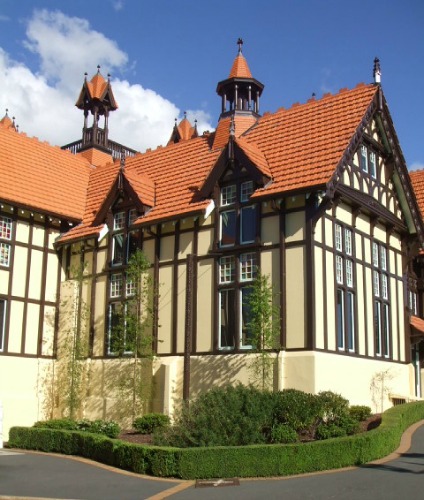 The towers and viewing platform in this side view pic
The towers and viewing platform in this side view picFinials and towers are numerous (one with a viewing platform and great views around Rotorua), as are windows of grid mullions and horizontal transoms with square leaded panes between.
One feature that Dr Wohlmann insisted on adding were the verandahs which were never part of the Elizabethan style. He wanted his patients to have a place to promenade after finishing their treatments.
Rotorua Museum - The Bath House Vision
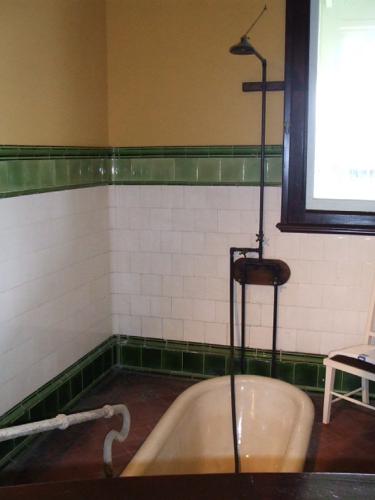
Initially it was built to attract the wealthy from the northern hemisphere. There was a vision that it would be the 'great south seas spa'.
What wasn't taken into account (or known about at the time) were the corrosive effects of hydrogen sulphide (sulphur) (pic on the right) and the acidic waters.
It corroded the metal piping and turned paint black causing maintenance costs to spiral out of control. Little did they know that something as simple as polyurethane piping could have negated a lot of these effects.
Other factors were the lack of a casino (like the
european spas), a change in medical fashion, two world wars and a
depression. The doors were finally closed on this period in history in
1966.
The Nightclub Years
At one point the building was in danger of being pulled down. Thankfully this didn't happen due to the lease being taken over with first, a restaurant, then a cabaret and finally the Tudor Towers nightclub (referred to as the Towers by locals).
A sunken dance floor was built above the main foyer (30 tons of steel was taken out when it was removed during the renovations).
Later a faux Tudor multi-tiered stage was also erected where the bands and dancers performed.
A lot of local New Zealand singers and musicians cut their teeth here during the nightclub years. Some also went on to become national and international singers of note.
One of the not so good things over these years was the fact the the
neo-classical sculptures housed in the building were damaged. Fingers
and toes, noses, wing-tips, arrows etc were broken off. There was no
appreciation for the fine pieces of art that they were.
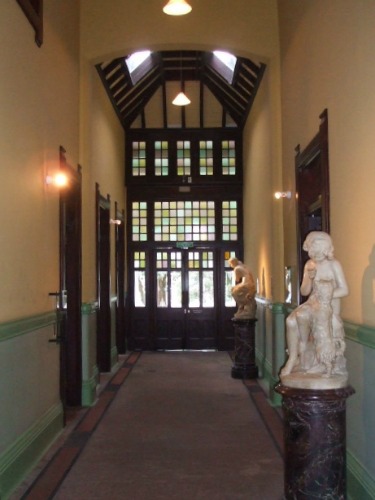 Rotorua Museum corridor with two of the neo-classical sculptures
Rotorua Museum corridor with two of the neo-classical sculpturesAs an aside, I don't know how we didn't break our necks coming down the staircase in the nightclub years.
I well remember being off my face with alcohol, lurching down the stairs in stilettos. I know a lot of other people have these types of memories too.
You can take it as said, that these were fun years.
When I think about it now it seems sacrilegious that this fine old building housed a nightclub. On the other hand, if it helped to stop the building being torn down then it was worth it.
When the lease ran
out in 1990 that was it, the end of another era and the beginning of
what is now The Rotorua Museum Of Art & History.
The Rotorua Museum Of Art & History - Now
Dr Wohlmann's original vision has now come to fruition and what a grand vision it was. The finished building is amazing.
To the right of the foyer are housed the galleries featuring the history of the Rotorua Te Arawa people. How they got here, how they coped with and adapted to this new land and what has happened since.
To the left of the foyer is a walk through the history of the Bath House. 'Taking The Cure' is the theme. Here you get to see the treatments taken, the damage from the sulphur and mementos from that time.
You can go down into the basement to the mud bath rooms or up through the roof spaces to emerge onto the viewing platform.
There are a number of areas that hold exhibitions that change periodically.
One good thing is the onsite cafe where you can kick back and relax as it takes a good wee while to go through everything.
Costs |Hours |Tours |Getting There
You can check out the costs and hours here on the museum website.
There are tours every hour with volunteer guides who are really passionate about Rotorua. This is included in the price of admission.
Use the google map directions below to help you find your way to the museum.
View Rotorua Museum Of Art & History in a larger map
When you come to Rotorua, don't miss visiting The Rotorua Museum Of Art
& History. It will give you a good feel for the area and the people.
Want To Learn More?
- Home
- Top 10 To Visit
- Rotorua Museum
